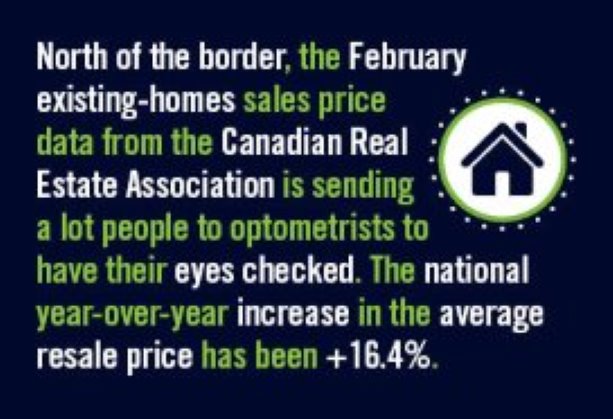North of the border, the February existing-homes sales price data from the Canadian Real Estate Association (CREA) is sending a lot people to optometrists to have their eyes checked.
(Continued from "Playing Home Price Hopscotch in U.S. and Canada (Part 1)".
For the nation as a whole, the year-over-year increase in the average resale price has been +16.4%. Three cities have contributed the largest bumps: Vancouver (+25.6%); Toronto (+14.9%); and Victoria (+11.3%).
Those same three cities are also leading Canada in terms of average resale price levels, with Vancouver busting through the one-million-dollars-CAD barrier
Vancouver’s $1,104,000 is followed by Toronto, at $685,000, and Victoria, $546,000.
Cities where the local economy is tied to one or more products (especially energy-related) in the faltering resource sector aren’t faring as well. Average resale home prices are currently -0.3% in Edmonton, -8.6% in Saskatoon and -10.7% in St. John’s, Newfoundland and Labrador.
Besides St. John’s on ‘The Rock’, other cities in the Atlantic Region are experiencing disturbing resale home price drops: Saint John, New Brunswick, -11.0%; Fredericton, -8.3%; and Halifax-Dartmouth, -3.5%.
Finally, there’s quite a ‘disconnect’ between CREA’s numbers for the year-over-year price increases of existing homes and what Statistics Canada is saying for newly-built housing.
The New Housing Price Index (NHPI) records a change of +1.8% year-over-year in this latest January, comprised of ‘land only’ at +1.3% and ‘house only’ at +2.0%.
Again, though, Toronto (+4.4%) and Vancouver (+3.1%) stand out as ‘hottest’ activity centers.
Victoria (0.0%) and Ottawa (-0.1%) stayed flat and there were declines in Saskatoon (-1.6%), Regina (-1.0%), Calgary (-0.9%) and Quebec City (also -0.9%).
By the way, there is a measure of new home prices in the U.S. as well. It appears in the joint press release on New Residential Sales from the Census Bureau and the Department of Housing and Urban Development (HUD).
In February 2016, for single-family homes in the U.S., the ‘median’ price stepped up by 2.6% year over year, while the ‘average’ price retreated by 2.0%.
There’s another distinction to be aware of when assessing these home price statistics. February’s ‘median’ price level of new homes for the U.S. as a whole was $301,400. The ‘average’ price level was $348,900.
The average price skews higher when there is a preponderance of luxury units on the market.
You know the kind of homes I mean. Borrowing from a long-ago TV show entitled ‘Lifestyles of the Rich and Famous’ (airing 1984 to 1995), they fulfill ‘champagne wishes and caviar’ dreams.











Recent Comments
comments for this post are closed